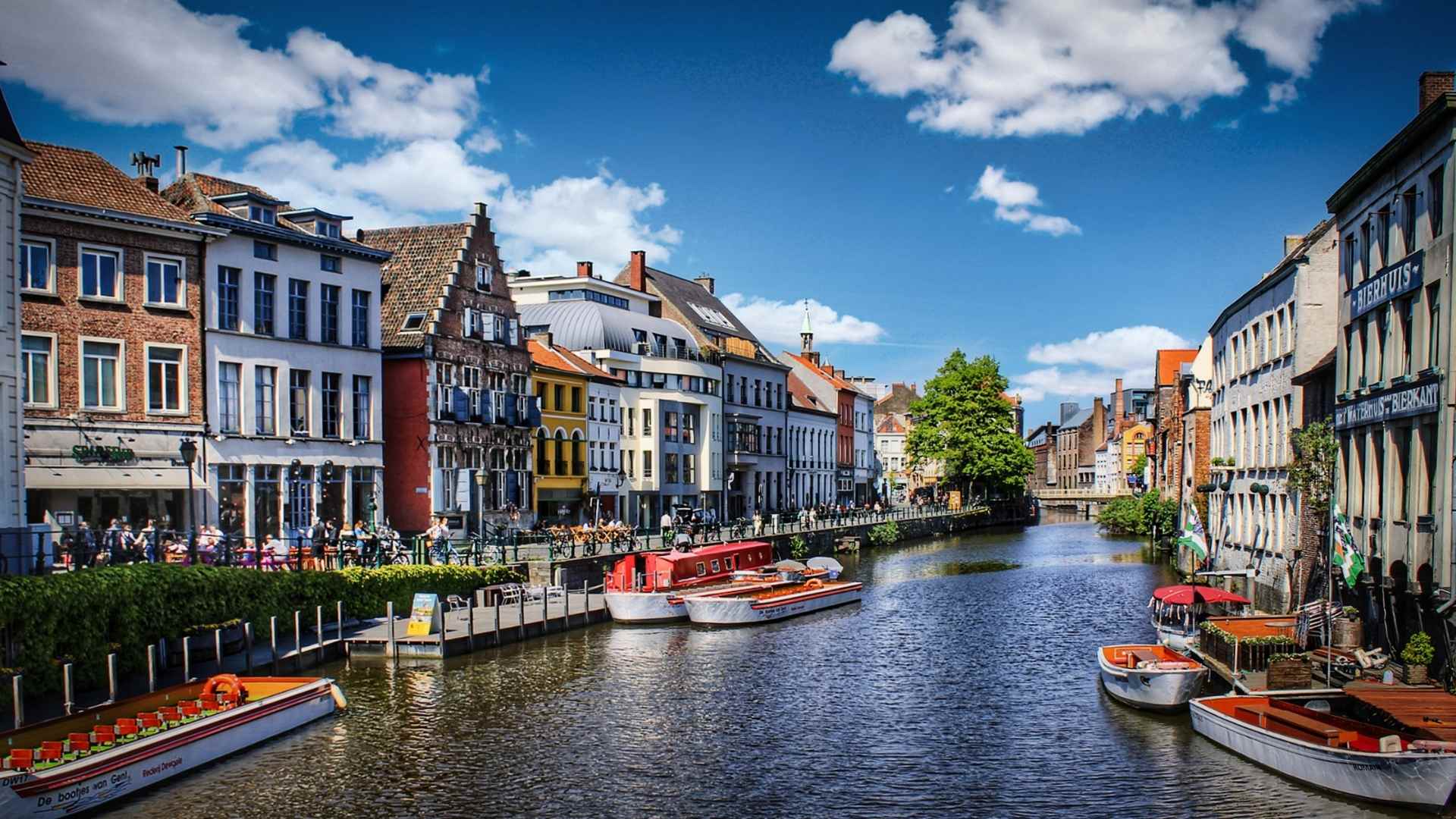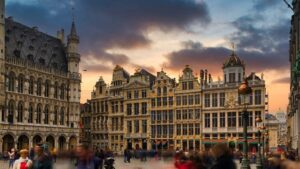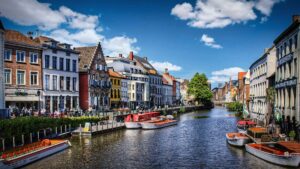Best Time to Visit Belgium
Belgium is a country rich in history, culture, and gastronomy, making it an incredible destination year-round. From medieval cities like Bruges and Ghent to cosmopolitan hubs like Brussels and Antwerp, there’s always something to explore. However, the best time to visit Belgium depends on your travel preferences, whether you’re looking for pleasant weather, fewer crowds, or exciting festivals.
Belgium experiences all four seasons, each offering unique travel opportunities. Spring brings blooming flowers and mild temperatures, making it ideal for sightseeing. Summer, while vibrant and packed with events like Tomorrowland and the Ghent Festival, also comes with larger crowds and higher prices. Fall provides a mix of comfortable weather and stunning autumn landscapes, perfect for beer lovers attending Belgium’s famous beer festivals. Meanwhile, winter transforms the country into a magical holiday destination, with charming Christmas markets in Brussels, Bruges, and Antwerp.
Whether you’re drawn to historic architecture, world-class chocolate and beer, or festive celebrations, timing your visit well can make your trip more memorable. In this guide, we’ll explore the best time to visit Belgium based on weather, budget, and activities, ensuring you make the most of your trip.

Table of contents
- Belgium’s Seasons: Weather and Climate Overview
- Spring (March to May): Blooming Beauty and Mild Weather
- Summer (June to August): Festivals, Warm Weather, and Tourists
- Fall (September to November): Fewer Crowds and Stunning Autumn Colors
- Winter (December to February): Christmas Markets and Cozy Atmosphere
- Best Time for Food Lovers: Indulging in Belgian Chocolate, Waffles, and Beer
- Best Time for Outdoor Activities and Sightseeing
- Best Time for Budget Travelers: How to Save on Flights and Hotels
Conclusion: Choosing the Best Time to Visit Belgium Based on Your Priorities
1. Belgium’s Seasons: Weather and Climate Overview
Belgium experiences a temperate maritime climate, meaning mild summers, cool winters, and frequent rainfall throughout the year. While no season guarantees completely dry weather, the best time to visit Belgium largely depends on your tolerance for rain and your preferred activities. The country’s weather can be unpredictable, so it’s always wise to pack an umbrella or raincoat, no matter when you visit.
Spring (March to May) offers mild temperatures ranging between 45°F and 65°F (7°C to 18°C), making it an excellent time for sightseeing. The countryside comes to life with blooming flowers, and major cities like Brussels, Bruges, and Ghent see fewer tourists compared to the summer months. This season is perfect for those who enjoy walking tours, garden visits, and outdoor cafés.
Summer (June to August) is the warmest time of year, with temperatures ranging from 60°F to 75°F (16°C to 24°C). Long daylight hours allow for extended exploration, but this is also peak tourist season. If you don’t mind crowds, summer is ideal for festivals, open-air markets, and beer gardens.
Fall (September to November) brings crisp air, stunning autumn foliage, and fewer tourists. This is a fantastic time for beer lovers, as several breweries and cities host beer festivals.
Winter (December to February) is cold and damp, with temperatures averaging 35°F to 45°F (2°C to 7°C). However, it’s also a magical time to visit, thanks to Christmas markets, cozy cafés, and fewer tourists outside the holiday weeks.
No matter your travel style, understanding Belgium’s seasons will help you decide the best time to visit Belgium based on weather, events, and personal preferences.
2. Spring (March to May): Blooming Beauty and Mild Weather
Spring is one of the best times to visit Belgium, offering a perfect balance of pleasant weather, fewer crowds, and beautiful landscapes. From March to May, temperatures gradually warm up, ranging from 45°F to 65°F (7°C to 18°C), making it an ideal time to explore Belgium’s charming cities on foot or by bike. While spring showers are common, they are usually brief and followed by sunshine, allowing for enjoyable sightseeing.
One of the highlights of visiting Belgium in spring is the blooming flowers and lush green parks. The famous Royal Greenhouses of Laeken in Brussels open to the public for a limited time in April and May, offering a stunning display of exotic plants and flowers. Similarly, Belgium’s Hallerbos Forest, known for its magical carpet of bluebell flowers, is at its most breathtaking in mid-April.
Another advantage of visiting in spring is the fewer crowds and lower prices compared to summer. Popular tourist destinations like Bruges, Ghent, and Antwerp are far less crowded, allowing for a more peaceful experience. Hotel rates and flights are also more affordable, making it a great option for budget-conscious travelers.
If you’re looking for mild weather, blooming landscapes, and a relaxed atmosphere, spring is undoubtedly the best time to visit Belgium before the summer crowds arrive.
3. Summer (June to August): Festivals, Warm Weather, and Tourists
Summer is the busiest and most vibrant time to visit Belgium, with long daylight hours, warm temperatures, and a packed festival calendar. From June to August, temperatures typically range between 60°F and 75°F (16°C to 24°C), creating perfect conditions for sightseeing day trips from Brussels, outdoor dining, and cultural events. While Belgium is known for its frequent rain, summer tends to have drier and sunnier days, making it a popular time for visitors.
One of the biggest draws of summer in Belgium is its festival scene. Music lovers flock to Tomorrowland, one of the world’s most famous electronic music festivals held in Boom, Belgium, while art and culture enthusiasts enjoy the Ghent Festival, a ten-day celebration of music, theater, and performances. Other notable events include the Brussels Summer Festival, the Ommegang historical parade, and the Tour de France when it occasionally passes through Belgium.
However, summer also brings larger crowds and higher prices. Popular cities like Bruges, Brussels, and Antwerp become packed with tourists, and hotel rates are at their peak. To make the most of your trip, booking accommodations well in advance is essential.
If you don’t mind the crowds and want to experience Belgium at its most lively, summer is the best time to visit Belgium for its warm weather, exciting festivals, and bustling city atmosphere.
4. Fall (September to November): Fewer Crowds and Stunning Autumn Colors
Fall is a wonderful time to visit Belgium, offering mild temperatures, stunning autumn foliage, and fewer tourists compared to the peak summer season. From September to November, temperatures gradually cool down, ranging from 50°F to 65°F (10°C to 18°C) in early fall and dropping to 40°F (5°C) by November. The crisp air and golden-hued landscapes make this season perfect for exploring Belgium’s historic cities, countryside, and forests.
One of the highlights of visiting Belgium in the fall is the changing colors of the trees, particularly in scenic areas like the Ardennes region, which becomes a paradise for hikers and nature lovers. The fewer tourists during this time also mean that top attractions, such as Bruges’ medieval squares and Ghent’s historic canals, are more peaceful and enjoyable. Hotel prices and airfare drop compared to the summer months, making fall an excellent time for budget travelers.
Beer lovers will also appreciate autumn in Belgium, as September brings the Belgian Beer Weekend in Brussels, a must-visit event for those looking to experience Belgium’s legendary brewing culture. If you’re looking for pleasant weather, fewer crowds, and a cozy, picturesque atmosphere, fall is the best time to visit Belgium for a relaxed and affordable trip.
5. Winter (December to February): Christmas Markets and Cozy Atmosphere
Winter in Belgium brings a charming, festive atmosphere, making it an ideal season for those who love holiday markets, historic cities covered in twinkling lights, and fewer tourists outside of peak holiday weeks. Temperatures during this time range from 35°F to 45°F (2°C to 7°C), with occasional frost and light snowfall, particularly in the Ardennes region. While Belgium’s winters are typically cold and damp, the cozy cafés, museums, and festive events more than make up for the chilly weather.
One of the main reasons to visit Belgium in winter is its spectacular Christmas markets. Cities like Brussels, Bruges, Antwerp, and Liège transform into winter wonderlands, offering traditional wooden stalls, ice skating rinks, and delicious seasonal treats like mulled wine, waffles, and speculoos cookies. The Winter Wonders festival in Brussels is particularly famous, featuring an illuminated Grand Place, a Ferris wheel, and holiday-themed performances.
Beyond the festive season, January and February are the best months for budget travelers, as hotel prices drop significantly after the holidays. While the cold weather may not be ideal for outdoor adventures, winter is a great time to explore Belgium’s world-class museums, historic castles, and rich culinary scene. If you’re looking for a festive, romantic, and budget-friendly getaway, winter could also be a good time to visit Belgium.
6. Best Time for Food Lovers: Indulging in Belgian Chocolate, Waffles, and Beer
Belgium is a paradise for food lovers, offering some of the world’s most iconic and indulgent treats, from crispy waffles and creamy chocolates to world-famous beers and hearty stews. While you can enjoy Belgian cuisine year-round, the best time to visit Belgium for food depends on the seasonal specialties you want to try.
Winter (December to February) is an excellent time to indulge in Belgium’s rich, warming dishes. Traditional comfort foods like moules-frites (mussels and fries), carbonnade flamande (Flemish beef stew), and creamy hot chocolate are especially enjoyable during the cold months. Christmas markets in Brussels, Bruges, and Antwerp also offer seasonal delights like mulled wine, speculoos cookies, and raclette cheese, making winter one of the most flavorful times to visit.
Spring and summer (March to August) bring a lighter, fresher food scene, with strawberries, fresh seafood, and outdoor dining in full swing. This is the perfect season to enjoy a cold Belgian beer on a sunny terrace or try local street food, like crispy frites served with homemade sauces. Beer lovers will enjoy the Belgian Beer Weekend in September, where they can sample the country’s most famous brews.
If your goal is to experience Belgium through its food and drink, the best time to visit Belgium depends on your cravings—whether it’s winter comfort food, fresh summer flavors, or beer festivals in the fall.
7. Best Time for Outdoor Activities and Sightseeing
Belgium’s charming cities, picturesque countryside, and scenic coastlines make it a fantastic destination for outdoor enthusiasts. Whether you enjoy walking tours, cycling, hiking, or exploring medieval towns, the best time to visit Belgium for outdoor activities largely depends on the weather and the type of experience you’re looking for.
Spring (March to May) is an excellent season for outdoor exploration, as the temperatures are mild (45°F to 65°F / 7°C to 18°C) and nature is in full bloom. This is the perfect time for cycling along the canals of Bruges, strolling through Brussels’ parks, or visiting the famous bluebell-covered Hallerbos Forest in April. The countryside is lush, and the cities are alive with open-air markets and flower festivals.
Summer (June to August) is ideal for those who want longer daylight hours and warmer temperatures, making it perfect for coastal visits, boat tours, and outdoor dining. However, it’s also the busiest time, so expect larger crowds at popular tourist spots.
For those who prefer cooler weather and stunning autumn colors, fall (September to November) is a fantastic option. The Ardennes region, with its dense forests and rolling hills, offers breathtaking hikes as the leaves turn golden.
If you’re planning a trip focused on exploring Belgium’s natural beauty and historic sites, the best time to visit Belgium is spring or fall, when the weather is comfortable, and the crowds are smaller.
8. Best Time for Budget Travelers: How to Save on Flights and Hotels
For travelers looking to experience Belgium without overspending, the best time to visit Belgium is during the off-season and shoulder seasons, when flight prices, accommodation rates, and tourist crowds are at their lowest. Generally, the most budget-friendly months to visit are January, February, March, and November, as these periods fall outside of the peak summer and holiday seasons.
Winter (January to February) is the absolute cheapest time to visit, with significantly lower hotel prices and fewer tourists at major attractions. While the weather is cold and rainy, this is an excellent time to explore Belgium’s rich museum scene, cozy cafés, and historic castles without the crowds. Flights to Brussels from major European and international cities also tend to be at their lowest during this period.
For those who want a mix of affordability and decent weather, November and early spring (March to April) are great choices. During these months, hotel rates are still lower than in summer, but the weather is more comfortable for sightseeing. Booking flights and accommodations in advance, traveling by train instead of renting a car, and eating at local markets instead of tourist-heavy restaurants can further cut costs.
If saving money is a priority, the best time to visit Belgium is during the off-season and early spring, when you can experience the country’s beauty and culture at a fraction of the price.
9. Choosing the Best Time to Visit Belgium Based on Your Priorities
Deciding on the best time to visit Belgium depends entirely on what you want to experience. Each season offers something unique, whether it’s festivals, food, outdoor adventures, or budget-friendly travel.
If you’re looking for ideal weather and picturesque landscapes, spring (March to May) is perfect, with blooming flowers, comfortable temperatures, and fewer crowds compared to summer. This is also a great time to enjoy cycling, walking tours, and sightseeing in Belgium’s historic cities. For those who love lively events and don’t mind tourist crowds, summer (June to August) is the busiest and most energetic season, offering long daylight hours and major festivals like Tomorrowland and the Ghent Festival.
For a more peaceful and budget-friendly trip, fall (September to November) is an excellent option. With stunning autumn colors, fewer tourists, and beer festivals, this season provides an authentic Belgian experience without the high prices of summer. If you’re a Christmas market enthusiast or a budget traveler, winter (December to February) is the best time to visit, with festive lights, cozy cafés, and discounted hotel rates after the holiday season.
Ultimately, Belgium is a year-round destination, and the best time to visit Belgium depends on your preferences for weather, crowds, and special events. No matter when you go, you’ll be greeted with rich history, delicious food, and charming cities waiting to be explored.



